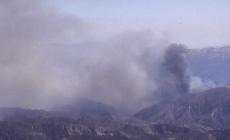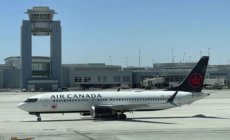-
Canyon fire explodes to nearly 5,000 acres; thousands evacuated in L.A., Ventura counties - 27 mins ago
-
Foreign Minister Welcomes U.S.-Russia Talks as “Hope for Central Europe” - 30 mins ago
-
California Breaks Near-100 Year Temperature Record - 42 mins ago
-
Christie Brinkley’s daughter put her on dating app with surprising results - 57 mins ago
-
‘They run, we chase’: Immigration raids test limits of “probable cause” - about 1 hour ago
-
‘Girl Guides of Canada’ Stops All US Trips Over Donald Trump’s Border crackdown - about 1 hour ago
-
Heatwave to Return with Weekend Temperatures Nearing 40°C - 2 hours ago
-
Law firm in L.A. homeless case bills $1.8 million for two weeks’ work - 2 hours ago
-
Airbnb Host Checks In ‘Polite’ Woman, Not Prepared For 5AM Call They Get - 2 hours ago
-
Arch Manning No. 1 Pick in 2026 NFL Draft? ‘He’ll be at Texas,’ says Archie - 2 hours ago
US Issues Update on New Hypersonic Weapon
The United States is scheduled to deploy a hypersonic weapon unit by the end of September, the Army said, as the Pentagon races to close the gap in this field with its major adversaries.
The Long-Range Hypersonic Weapon (LRHW) is scheduled to deploy its first operational battery by the end of fiscal year 2025, the Army said in a written response to Newsweek.
Each LRHW battery consists of four launchers equipped with a total of eight hypersonic missiles—which have a reported range of 1,725 miles—alongside a Battery Operations Center (BOC) and a support vehicle, according to a Congressional Research Service report.
Why It Matters
A hypersonic weapon can travel at Mach 5 or faster—over five times the speed of sound. Both of the U.S.’s major rivals—Russia and China—as well as regional adversaries such as North Korea and Iran say they have developed and deployed this new class of weapon.
In July, the U.S. Army deployed the LRHW outside the continental U.S. for the first time, with two missile launchers participating in Exercise Talisman Sabre 2025 in Australia.
The U.S. is also enhancing its defense against the hypersonic threat, including upgrades to missile defense radar systems, as this type of weapon can maneuver during flight—unlike ballistic missiles, which follow a predictable trajectory—making it difficult to intercept.
What To Know
“As of mid‑2025, testing continues, with the Master Test Strategy projecting activity through fiscal year 2026,” the U.S. Army told Newsweek regarding the status of the LRHW, also known as Dark Eagle. Fiscal year 2026 runs from October 1, 2025, to September 30, 2026.
According to the Congressional Research Service report, the LRHW was originally planned to field its first battery in fiscal year 2023. However, the program faced testing delays and cancellations, which ultimately prevented the Army from meeting its deployment goal.
The Army also confirmed to Newsweek that it deployed the LRHW to Australia temporarily. The weapon system was assigned to the Hawaii-based Third Multi-Domain Task Force.
Sgt. Perla Alfaro/U.S. Army
In a news release on Tuesday, U.S. Army Pacific described the task force as having made a “groundbreaking achievement” during the Australia-hosted war game through the LRHW’s deployment, which was integrated into constructive mission threads throughout the exercise.
The LRHW’s “over-the-horizon, long-range communication” capabilities were validated, and the deployment underscored the Army’s ability to project power in the Indo-Pacific theater.
“The Dark Eagle is truly ready to go,” said Captain Jennifer Lee, the commander of the LRHW unit known as Bravo Battery, adding that the exercise demonstrated the weapon system’s capabilities and validated the unit’s readiness and ability to defend U.S. allies and partners.
What People Are Saying
U.S. Army Captain Jennifer Lee, the commander of the LRHW unit known as Bravo Battery, said in a news release on Tuesday: “The employment of the Dark Eagle capability during the exercise underscores our commitment to strengthening alliances and enhancing interoperability with our partners in the Indo-Pacific region.”
U.S. Navy Admiral Samuel J. Paparo, the commander of the U.S. Indo-Pacific Command, said in a news release on August 2: “The deployment of the LRHW system to Australia marks a significant achievement for U.S. Indo-Pacific Command, as it validates the Army’s ability to deploy, position, and exercise command and control (C2) of the system in a forward environment.”
What Happens Next
It remains to be seen whether the U.S. Army will conduct another overseas deployment before the LRHW fields its first operational battery.
Source link































